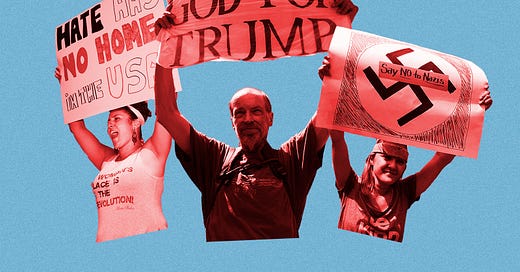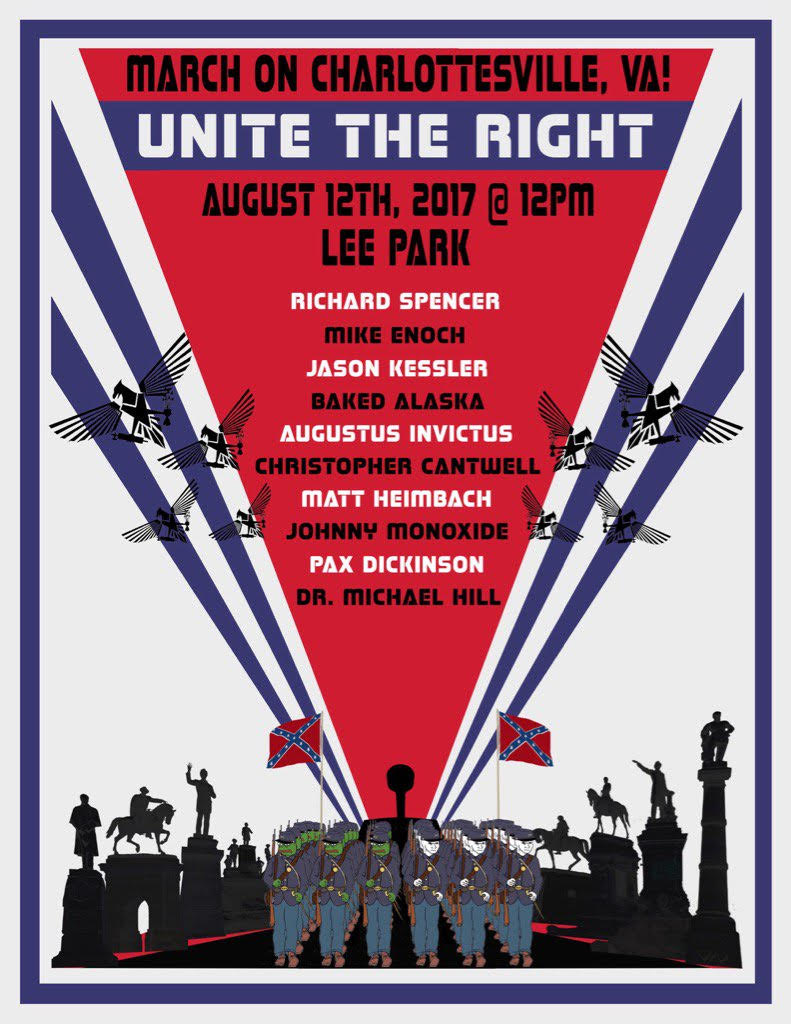
I RECENTLY LAMENTED that the Democratic party’s embrace of antisemitism was helping Donald Trump get off the hook for referring to white nationalists rioting in Charlottesville as “very fine people.” I expected, and received, furious replies from Trump supporters who deny that the president ever said any such thing.
This has become official dogma on the Trump-supporting right and has solidified into a name, the “Charlottesville Hoax.” Steve Cortes recently called it that, drumming the message home by calling it a “damnable lie,” a “calumny,” and a “willful deception.” I was not surprised to see the Federalist’s Mollie Hemingway link to this approvingly and pontificate, “I have personally witnessed how difficult it is for smart, thoughtful people to accept what Trump actually said, instead of what they ‘remember’ him saying, but it’s really important that we speak accurately here and criticize for real things, not fake.”
Personally, I found this deeply ironic, because I watched in disbelief over a period of about a year as my then-colleagues at the Federalist did precisely that: rewrite this story in their minds to create a more palatable version that would fit comfortably with their support for Trump.
Hemingway has accused the media of “gaslighting” the public. But that’s exactly what she’s doing here, trying to make us think we are suffering from some kind of False Memory Syndrome when it comes to Trump’s Charlottesville comments.
So let’s do what Trump’s apologists keep asking us to do and look at what he actually did say.
Trump’s defenders point to his insistence in his August 15, 2017, Trump Tower news conference that when he said “very fine people” he was “not talking about the neo-Nazis and white nationalists because they should be condemned totally.” Case closed, right?
The problem is that Trump is not a very reliable source on what he is and is not talking about, and he had in fact just been talking about white nationalists. Let’s take a closer look at that transcript and see exactly who he was referring to when he was talking about “very fine people.”
Here’s the actual “very fine people” comment:
You have some very bad people in that group. But you also had people that were very fine people, on both sides. You had people in that group—excuse me, excuse me—I saw the same pictures as you did. You had people in that group that were there to protest the taking down of, to them, a very, very important statue and the renaming of a park from Robert E. Lee to another name.
So when he says “very fine people” he is referring to a specific group of protesters, and not only does he keep emphasizing this, but he gets more specific about them.
But not all of those people were Neo-Nazis, believe me. Not all of those people were white supremacists, by any stretch. Those people were also there because they wanted to protest the taking down of a statue, Robert E. Lee. So this week it’s Robert E. Lee. I noticed that Stonewall Jackson’s coming down. I wonder, is it George Washington next week? And is it Thomas Jefferson the week after? You know, you all—you really do have to ask yourself, where does it stop? But they were there to protest—excuse me. You take a look, the night before, they were there to protest the taking down of the statue of Robert E. Lee.
And later in the press conference:
There were people in that rally, and I looked the night before. If you look, they were people protesting very quietly the taking down of the statue of Robert E. Lee. I’m sure in that group there were some bad ones. The following day, it looked like they had some rough, bad people—neo-Nazis, white nationalists, whatever you want to call them. But you had a lot of people in that group that were there to innocently protest and very legally protest, because you know—I don’t know if you know, they had a permit.
He keeps going back to this idea that there was a separate group of protesters that weekend in Charlottesville, ordinary people who merely opposed the removal of Lee’s statue, and he keeps giving that group a specific time and place: in Charlottesville “the night before,” that is, the night of Friday, August 11.
Cortes claims that “Trump’s ‘fine people on both sides’ observation clearly related to those on both sides of the Confederate monument debate.” In other words, it was just a vague, general observation that good people can disagree on the issue. But as we’ve just seen, that’s not what Trump was saying. He was referring to a specific group of protesters present in Charlottesville on the night of August 11. And this was the context in which Trump denied that he was talking about white nationalists.
And you had people, and I’m not talking about the neo-Nazis and the white nationalists, because they should be condemned totally. But you had many people in that group other than neo-Nazis and white nationalists. Okay? And the press has treated them absolutely unfairly.
All right, so who are these people who were just there to protest the removal of the statues? Who was the group protesting “the night before”?
Well, here they are:
That’s right. The people marching in Charlottesville the night before were the guys with torches chanting “blood and soil” and “Jews will not replace us.”
So you can see where the mainstream view of this statement comes from. Cortes describes Trump’s words as “unambiguous” but his actual words are the very definition of ambiguity: He is denouncing the Nazis out of one side of his mouth, then calling them “very fine people” out of the other. He is saying, in effect, that he condemns the white nationalists but also that the people marching with torches and shouting at the Jews were very fine people. Do you find that a convincing “condemnation”? Would you find it convincing if any other politician said it?
What if there really was another group of protesters there that day, and that’s who Trump was referring to? Well, there’s the problem. No such group exists. This mythical second group of protesters is like the “second shooter” in conspiracy theories about the Kennedy assassination. I’ve found people who insist to me that such a group was there because the “Charlottesville Hoax” mythology requires it to exist—but I haven’t found a single shred of actual confirmation. It’s almost as if they have adopted a false memory.
That’s what originally set me off about this Trump claim. I live in the Charlottesville area, and I know very fine people who oppose the removal of the monuments based on high-minded notions about preserving history. I’m one of them. So I know that we weren’t there that night. Only the white nationalists were there.
If you’re counting, we’ve already busted two parts of the “Charlottesville Hoax” myth. Trump was not talking generally about people on both sides of the statue controversy, he was talking about a specific group—and there was no specific group other than the white nationalists present at the events Trump was referring to.
At this point, the only argument in Trump’s defense is one that I would regard as fairly plausible: Trump was, once again, blustering about a subject he didn’t understand, while insisting that he knew it better than anyone else. (You can see why this defense is not widely employed, because it doesn’t serve the purpose of making people feel more comfortable about the man in the White House.)
There’s also the fact that Trump repeatedly insisted in his Trump Tower press conference that he had painstakingly gathered the facts. “When I make a statement, I like to be correct. I want the facts.” He repeated, “unlike you and unlike the media, before I make a statement, I like to know the facts.”
But what really gives the game away is when Trump insists that the “very fine people” who were there to protest “had a permit.” There was only one protest permit issued that weekend, and it was well documented because there was a court battle over it. That wasn’t for the Friday night’s tiki-torch Nuremberg, which was unannounced, but for the “Unite the Right” rally on Saturday. So were there “fine people on both sides” of the permitted rally? Let’s take a look at which parts of the “right” this rally was supposed to unite. One source describes them as “the alt-right, neo-Confederates, neo-fascists, white nationalists, neo-Nazis, Klansmen, and various militias”—in other words, different variations on the theme of white nationalism. If you think that’s an unfair summary, check out the poster for the event and notice that the headline speaker was prominent white nationalist Richard Spencer.
So this was not some kind of big-tent rally for supporters of the monuments that just happened to be hijacked by white nationalists. It was a rally organized specifically by, and for, white nationalists. Which is why the Virginia ACLU had to go to bat for their right to protest.
The best—the very best—one could say about Trump’s comments on Charlottesville is that he did not intend to praise Nazis but merely blundered into a statement that ended up being disastrously ambiguous. Yet this was hardly the first time. The Trump Tower press conference was his third public statement about Charlottesville, which was necessary because he had already bungled the first two. His wishy-washy first statement, in which he blamed the violence in Charlottesville on “hatred, bigotry, and violence on many sides, on many sides,” had set the tone.
We all know that a president who was basically competent and gave a damn could have delivered an unambiguous condemnation of white nationalism and appealed to unifying American values. We know because we’ve seen it before.
The fact that Trump couldn’t do this implies to me that he didn’t really care all that much about the subject. In fact, throughout his whole Trump Tower press conference, he kept begging the reporters to ask him questions about infrastructure spending. He clearly wanted to talk about something, anything, else.
That’s why Trump’s Charlottesville statement deserves to be remembered as a dangerous sign. It shows the corruption in Trump’s outlook on the world that makes him unwilling to deal with a clear threat to American values—and, in the coiled obfuscations of the “Charlottesville Hoax” myth, it shows how he corrupts the minds and values of his apologists.

















